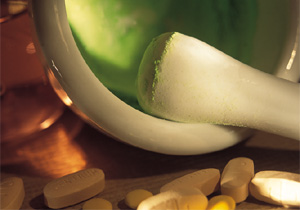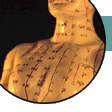Differentiating Syndromes according to the Sanjiao Theory
Differentiating syndromes according to the theory of sanjiao is a
method of analyzing damp-heat syndromes in febrile diseases caused
by exogenous pathogenic factors. Damp-heat syndromes are caused by
exogenous pathogenic damp and heat, so the disease duration is long
and the condition is complicated. Pathological changes are mainly
in the middle jiao, especially concentrated in the spleen and stomach.
At the early stage of damp-heat diseases there is no clear margin between
wei (outer defensive) stage, and qi (inner defensive) stage. Also,
before damp-heat is transformed into dryness, it may be transformed into
ying (nutrient) stage, and xue (blood) stage. So it is difficult to
differentiate damp-heat diseases by using the theory of wei, qi, ying,
and xue. Generally, pathogenic damp and heat spread through all the
upper, middle, and lower jiao to obstruct the circulation of qi, and
block the smooth transportation and transformation of water and fluid.
Thus, the method of differentiating syndromes according to the theory
of sanjiao is used to analyze these diseases.
The syndromes of the upper, middle, and lower jiao are generalizations
of the three kinds of symptom-complex, and a reflection of disease
development from upper to lower, from superficial to deep, and from
mildness to severity.
Damp-Heat in the Upper Jiao
Damp-heat in the upper jiao indicates the early stage of pathogenic
injury. The main pathological changes are in the lung and body surface.
Main clinical manifestations: Severe aversion to cold, little or no fever, no sweating, heaviness and pain of the body, distending pain of the head, deafness, dullmind, indifferent emotions, hypersomnia, poor appetite, white sticky tongue coating, soft and weak pulse.
Damp is a yin pathogenic factor which attacks yang qi easily, so there is severe aversion to cold and a slight fever. Pathogenic damp obstructing the body surface muscles causes an absence of sweating and pain. Pathogenic damp is characterized by heaviness and turbidity, so the manifestations of heaviness of the body and distending pain of the head occur. Pathogenic damp misting of clear yang results in deafness, dullmind, indifferent emotions and hypersomnia. Poor appetite is caused by the retention of damp in the spleen and stomach. A white sticky tongue coating and a soft weak pulse are signs of excessive damp.
Damp-Heat in the Middle Jiao
Damp-heat in the middle jiao transmits from the upper jiao. The main
pathological changes show the disturbance of damp on qi activities, and
abnormal ascending and descending of middle jiao qi.
Main clinical manifestations: Fever, stuffiness and distension of the chest and epigastric region, anorexia, loose stools, scanty and yellowish urine, light yellow color of the face and eyes, grayish, pale and slightly yellow tongue coating, dullmind, coldness of the lower legs, and soft pulse.
Damp mixed with heat causes fever. Damp also obstructs the qi activities and disturbs its function of ascending and descending, so stuffiness and distension of the chest and epigastric region, anorexia, and loose stools occur. Steaming of damp and Steaming of damp and heat causes alight yellow face and eyes. yang qi fails to spread over the four extremities due to a blockage of clear yang by damp, so a dull mind, and coldness of the lower legs result. Grayish, pale, and slightly yellow tongue coating, and a soft pulse are signs of excessive damp-heat.
Damp-heat in the Lower Jiao
Damp-heat in the lower jiao arises from the middle jiao. The main
pathological changes are characterized by problems of the urinary bladder
and large intestine.
Retention of damp in the urinary bladder: Dysuria, distending pain and dizziness of the head, fullness and stuffiness of the epigastric and abdominal regions, grayish-white and yellow-sticky tongue coating, unsmooth bowel movements, and soft pulse.
Retention of dampness deranges the qi activities of the urinary bladder, manifesting as dysuria. Distending pain and dizziness of the head, and fullness and stuffiness of the epigastric and abdominal regions are caused by the failure of yang qi to ascend because of the spreading of damp-heat through the upper, middle, and lower jiao. Unsmooth bowel movements are the result of damp-heat retention in the large intestine. Grayish-white, yellow-sticky tongue coating, and a soft pulse are signs of excessive internal damp-heat.
Retention of damp in the large intestine: Constipated stool, fullness of the lower abdomen, distension of the head, stuffiness of the epigastrium, grayish and yellow-sticky tongue coating, and soft pulse.
Grayish and yellow-sticky tongue coating, and soft pulse indicate interior retention of excessive damp-heat. Distension of the head, and stuffiness of the epigastrium indicate damp-heat remaining in the upper, middle, and lower jiao, in which the qi activities of the sanjiao are blocked. Constipation and fullness of the lower abdomen are due to the stagnation of dampness disturbing the large intestine.
|

 This website is published, edited and designed by Raymond Cheng,
and reflects only and only his personal views and opinions in his individual capacity.
The information available at this website is not intended
directly or by implication to either diagnose or treat any
medical, emotional, or psychological condition or disorder.
It is also not intended to create a physician-patient relationship
between you and I or between you and Wyith Institute™ and The Office of Dr Raymond K K Cheng.
The information here is not a substitute for advice and treatment provided
by your physician or by another healthcare professional.
It is always recommended that consultation with local healthcare providers
be obtained for any of your specific health or medical concerns.
Furthermore, any products that can be purchased (yet you can see I don't have much
to sell here) through advertisers' banners or through links to other websites
are not either explicitly or implicitly given any warranty or endorsement
by me, my colleagues, Wyith Institute™ or any of its associated businesses.
This website is published, edited and designed by Raymond Cheng,
and reflects only and only his personal views and opinions in his individual capacity.
The information available at this website is not intended
directly or by implication to either diagnose or treat any
medical, emotional, or psychological condition or disorder.
It is also not intended to create a physician-patient relationship
between you and I or between you and Wyith Institute™ and The Office of Dr Raymond K K Cheng.
The information here is not a substitute for advice and treatment provided
by your physician or by another healthcare professional.
It is always recommended that consultation with local healthcare providers
be obtained for any of your specific health or medical concerns.
Furthermore, any products that can be purchased (yet you can see I don't have much
to sell here) through advertisers' banners or through links to other websites
are not either explicitly or implicitly given any warranty or endorsement
by me, my colleagues, Wyith Institute™ or any of its associated businesses.



 Thank you for visiting this TCM and acupuncture information website.
If you have previously been to this website, you might have
noticed that some of the pages on ancient historical ideas and
holistic thinkings related to Chinese metaphysics are temporarily taken offline.
This is because I will be revamping the whole website and be moving
those information into a new \"Ancient Chinese Culture\" section
so as to reflect a more current perspective on the interpretation
of some of the fundamental concepts as well as to include
some of the latest information in the area.
But if you have just found this website for the very first time, I welcome you again and
wish you could find what you require and, hopefully, you could also be benefitted
from reading the articles I published on this website.
Thank you for visiting this TCM and acupuncture information website.
If you have previously been to this website, you might have
noticed that some of the pages on ancient historical ideas and
holistic thinkings related to Chinese metaphysics are temporarily taken offline.
This is because I will be revamping the whole website and be moving
those information into a new \"Ancient Chinese Culture\" section
so as to reflect a more current perspective on the interpretation
of some of the fundamental concepts as well as to include
some of the latest information in the area.
But if you have just found this website for the very first time, I welcome you again and
wish you could find what you require and, hopefully, you could also be benefitted
from reading the articles I published on this website.